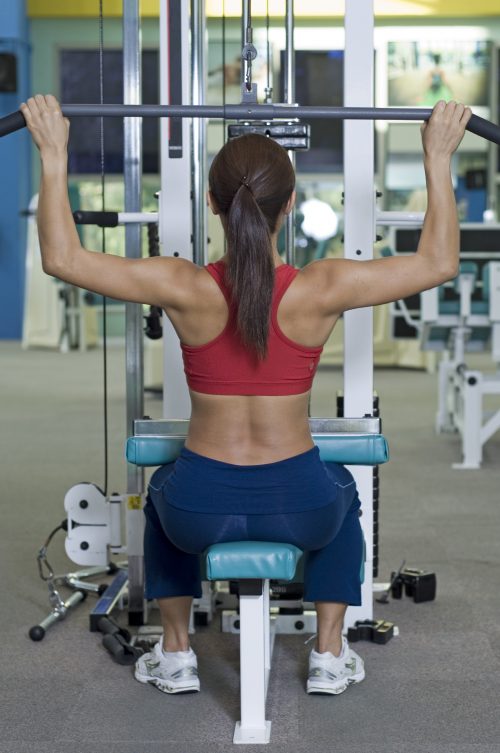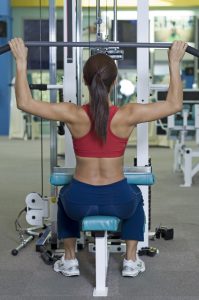Exercise Name & Target Muscle Group
The Lat Pulldown is a surprisingly complex exercise that involves far more than the latissimus dorsi muscle. The predominant muscle groups involved also include the teres major, middle and lower trapezius, rhomboids, posterior deltoid, brachialis, biceps brachii, and brachioradialis.
That’s a lot of muscles for an exercise named for training the lats! While not all of these muscles are considered the prime mover for this exercise, they are working during the lift.
Why It’s Performed
The lat pulldown is used to target the larger muscles of the back. The primary joint movements that occur during the exercise are shoulder adduction (lats and the teres major), scapular retraction and depression (middle and lower trapezius and rhomboids), shoulder extension (lats and teres major), and elbow flexion (brachialis, biceps brachii, and brachioradialis)
Proper Execution
To perform a proper lat pulldown (like the one pictured above), execute it by:
Starting Position
- Grasping the bar with a closed, pronated grip. Note: if the bar is entirely straight, use a grip that is wider than shoulder-width and spaced evenly on the bar.
- Sit on the seat with legs bent and thighs under the thigh pads. Keep the feet flat on the floor (adjust the seat height accordingly).
- The elbows should be fully extended with the selected load suspended above the remaining weights in the stack.
- Lean slightly backward and extend the neck to create a clear path for the bar to pass by the face as it’s pulled downward. This position also reduces the possibility of impingement stress on the shoulder joints.
- All reps begin from this position.
Downward Phase
- Pull the bar downward with the elbows moving down and back and the chest up and out as the bar is lowered.
- Maintain the same torso position and do not use momentum.
- Continue pulling the bar down and toward the body until it lightly touches the clavicles. The torso should still be leaning back slightly.
Upward Phase
- Slowly and in a controlled fashion, guide the bar back up to the starting position.
- Maintain the torso position.
- The elbows should be fully extended and the end of the movement.
Variations of the Exercise
The lat pulldown can be performed in a variety of ways including the following.
- Resistance Band Row
- Single-arm lat pull
- Close-grip lat pull
- Wide-grip lat pull
- Alternating lat pull
The pull-up is also a great exercise to target similar muscle groups. Instead of pulling the weight down as in a lat pulldown, the weight of the body is pulled up towards a bar.
Common Errors
-
- Improper seat height
- Hands too close together or too far apart on the bar
- Not using a full range of motion to perform the movement
- Pulling the bar behind the neck
- Leaning the torso too far back
- Using momentum or a jerking motion to lift more weight than is reasonable
- Pulling the bar to the hips and not the clavicle
________________________________
Already a personal trainer, but not with NFPT? See how we can be a great fit for you! Check out the 3-Step Certification Process
Thinking about a career as a personal trainer? Get the TRAINER CAREER GUIDE!




